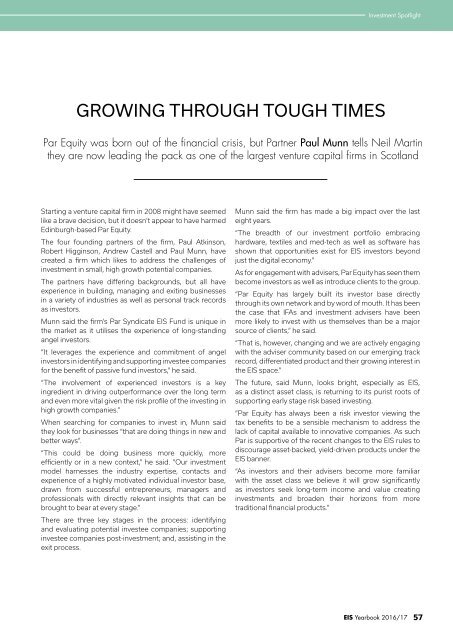2fnoNyY
2fnoNyY
2fnoNyY
You also want an ePaper? Increase the reach of your titles
YUMPU automatically turns print PDFs into web optimized ePapers that Google loves.
Investment Spotlight<br />
GROWING THROUGH TOUGH TIMES<br />
Par Equity was born out of the financial crisis, but Partner Paul Munn tells Neil Martin<br />
they are now leading the pack as one of the largest venture capital firms in Scotland<br />
Starting a venture capital firm in 2008 might have seemed<br />
like a brave decision, but it doesn’t appear to have harmed<br />
Edinburgh-based Par Equity.<br />
The four founding partners of the firm, Paul Atkinson,<br />
Robert Higginson, Andrew Castell and Paul Munn, have<br />
created a firm which likes to address the challenges of<br />
investment in small, high growth potential companies.<br />
The partners have differing backgrounds, but all have<br />
experience in building, managing and exiting businesses<br />
in a variety of industries as well as personal track records<br />
as investors.<br />
Munn said the firm’s Par Syndicate EIS Fund is unique in<br />
the market as it utilises the experience of long-standing<br />
angel investors.<br />
“It leverages the experience and commitment of angel<br />
investors in identifying and supporting investee companies<br />
for the benefit of passive fund investors,” he said.<br />
“The involvement of experienced investors is a key<br />
ingredient in driving outperformance over the long term<br />
and even more vital given the risk profile of the investing in<br />
high growth companies.”<br />
When searching for companies to invest in, Munn said<br />
they look for businesses “that are doing things in new and<br />
better ways”.<br />
“This could be doing business more quickly, more<br />
efficiently or in a new context,” he said. “Our investment<br />
model harnesses the industry expertise, contacts and<br />
experience of a highly motivated individual investor base,<br />
drawn from successful entrepreneurs, managers and<br />
professionals with directly relevant insights that can be<br />
brought to bear at every stage.”<br />
There are three key stages in the process: identifying<br />
and evaluating potential investee companies; supporting<br />
investee companies post-investment; and, assisting in the<br />
exit process.<br />
Munn said the firm has made a big impact over the last<br />
eight years.<br />
“The breadth of our investment portfolio embracing<br />
hardware, textiles and med-tech as well as software has<br />
shown that opportunities exist for EIS investors beyond<br />
just the digital economy.”<br />
As for engagement with advisers, Par Equity has seen them<br />
become investors as well as introduce clients to the group.<br />
“Par Equity has largely built its investor base directly<br />
through its own network and by word of mouth. It has been<br />
the case that IFAs and investment advisers have been<br />
more likely to invest with us themselves than be a major<br />
source of clients,” he said.<br />
“That is, however, changing and we are actively engaging<br />
with the adviser community based on our emerging track<br />
record, differentiated product and their growing interest in<br />
the EIS space.”<br />
The future, said Munn, looks bright, especially as EIS,<br />
as a distinct asset class, is returning to its purist roots of<br />
supporting early stage risk based investing.<br />
“Par Equity has always been a risk investor viewing the<br />
tax benefits to be a sensible mechanism to address the<br />
lack of capital available to innovative companies. As such<br />
Par is supportive of the recent changes to the EIS rules to<br />
discourage asset-backed, yield-driven products under the<br />
EIS banner.<br />
“As investors and their advisers become more familiar<br />
with the asset class we believe it will grow significantly<br />
as investors seek long-term income and value creating<br />
investments and broaden their horizons from more<br />
traditional financial products.”<br />
EIS Yearbook 2016/17<br />
57


